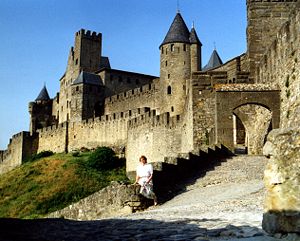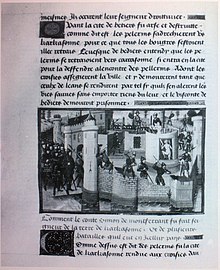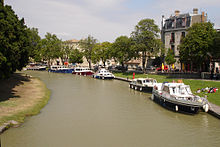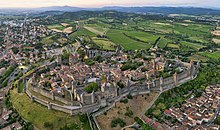Carcassonne
|
Carcassonne Carcassona |
||
|---|---|---|

|
|
|
| region | Occitania | |
| Department | Aude | |
| Arrondissement | Carcassonne | |
| Canton |
Carcassonne-1 Carcassonne-2 Carcassonne-3 |
|
| Community association | Carcassonne Agglo | |
| Coordinates | 43 ° 13 ′ N , 2 ° 21 ′ E | |
| height | 81-250 m | |
| surface | 65.08 km 2 | |
| Residents | 46,031 (January 1, 2017) | |
| Population density | 707 inhabitants / km 2 | |
| Post Code | 11000 | |
| INSEE code | 11069 | |
| Website | www.carcassonne.org | |
 Cité de Carcassonne - Château Comtal and Porte d'Aude |
||
Carcassonne ( Occitan : Carcassona ) is a municipality with 46,031 inhabitants (as of January 1, 2017) in southern France and a prefecture of the Aude department . It is the seat of the community association Carcassonne Agglo with over 105,000 inhabitants. Its landmark is the medieval fortress located on a hill in the old town, known as the Cité of Carcassonne .
Carcassonne is about 70 kilometers northwest of Perpignan on an old trade route between the Mediterranean and the Atlantic . The city lies on the rivers Aude and Fresquel and is crossed by the Canal du Midi .
history
Carcassonne was than in ancient times in the area of Volcae Tectosages lay Carcas (s) o . Its inhabitants had Latin citizenship under Roman rule. Now Carcaso belonged to the province of Gallia Narbonensis . Caesar had an arsenal and war magazines built here. The place was called Colonia Iulia Carcaso in Roman times . In 462 it fell to the Visigothic King Theodoric II. The diocese of Carcassonne was founded in 533. At Carcassonne, Rekkared I defeated the Franks in 589 . The Visigoths held the city until it was conquered by Saracens from Spain in 725 . Meanwhile, Arab rule only lasted until about 759, when Pepin the Younger subjugated all of Septimania and united it with the Frankish Empire.
The city then became the seat of counts ; the first known by name was called Bello and ruled at the beginning of the 9th century at the time of Charlemagne . After Raimund Roger's death (1067), Carcassonne came formally under the sovereignty of the Counts of Barcelona or Kings of Aragón , but the now Vice Counts of Carcassonne , who came from the House of Trencavel , ruled largely independently.
In the Middle Ages, 3,000–4,000 people lived in Carcassonne, which was one of the main bases of the Cathars at the beginning of the 13th century . In 1209 it was the destination of the Albigensian Crusade . The city was already overcrowded with refugees and offered to surrender after a two-week siege. The residents used the two weeks to flee through underground passages into the nearby forests. About 500 inhabitants remained, mainly old people, the sick and children. Of these, 100 were allowed to leave the city, the other 400 were burned or hanged . In 1247 the last Vice Count of Carcassonne, Raimund II. Trencavel , finally renounced Louis IX. on his claims to the city that was now part of the French crown domain .
From 1247 the lower town was built on the left bank of the river. According to the Treaty of Corbeil (1258), Carcassonne became a frontier fortress between France and the Kingdom of Aragon. In the early stages of the Hundred Years War , the English captured the Lower City in 1355 and burned it down. In 1591 Carcassonne fell into the hands of the Holy League , which did not recognize Henry IV as French king until 1596 .
The lower town developed over the centuries following its founding; This is where the majority of people live today. In contrast, today's old town, especially the fortress on the hill, has increasingly fallen into disrepair over the centuries. The fortress was first restored in 1853 by Eugène Viollet-le-Duc and is now in the old town.
The Canal du Midi initially led past the city because you do not participate enough in the cost of its construction. The construction of the guided tour through the city, which is more favorable for trade, began in 1786 and was not completed until the beginning of the 19th century due to the interruption caused by the French Revolution .
In an Islamist attack and subsequent hostage-taking in Carcassonne and neighboring Trèbes , a 26-year-old man killed four people and injured at least twelve others on March 23, 2018.
Population development
| year | 1962 | 1968 | 1975 | 1982 | 1990 | 1999 | 2006 | 2017 |
|---|---|---|---|---|---|---|---|---|
| Residents | 40,897 | 43,616 | 42,154 | 41,153 | 43,470 | 43,950 | 46,639 | 46,031 |
Sources: Cassini and INSEE
Attractions
Cité of Carcassonne
The Cité de Carcassonne on the right bank of the Aude belongs since 1997 to the World Heritage of UNESCO . It is the city's main tourist attraction with 4 million visitors a year and one of the most visited destinations in France.
The medieval fortress is unique in Europe in terms of its size and state of preservation. The Cité, which is still inhabited, is enclosed by a double wall ring. The main buildings inside are a castle ( Château comtal ) and a church ( Basilique Saint-Nazaire ).
Former Saint-Nazaire and Saint-Celse Cathedral
In 1096 Pope Urban II visited the city and blessed the stones intended for a new building. The Romanesque building that forms today's nave was probably completed around the middle of the 12th century. The expansion in the Gothic style lasted until 1330. The cathedral was the seat of a bishopric until 1801.
Saint-Michel cathedral
This church was built in the 13th century as a simple parish church. As part of the Concordat of 1801, the church was elevated to the Cathedral of the Diocese of Carcassonne .
Others
Inside the castle, the château comtal ("Count's Castle") was built in 1127 . Inside the castle town, its walls form a rectangle protected by five towers and a moat. The Canal du Midi ("Canal of the South") connects Toulouse with the Mediterranean at Sète. The Saint-Gimer church was built in the years 1854-1859 by Eugène Viollet-le-Duc. Other attractions are:
- The Bastide Saint-Louis
- The old bridge Pont Vieux from the 14th century
- The Fountain of Neptune on Place Carnot (18th century)
- The market halls (Les Halles)
See also: List of Monuments historiques in Carcassonne
traffic
Carcassonne is on the A61 autoroute that connects Narbonne with Toulouse . The city can be reached by rail via the railway line from Bordeaux to Sète and the railway line to Rivesaltes, which begins in Carcassonne . Carcassonne Airport is to the west of the town .
The city as a location for films
Carcassonne was and is often used as a film set and also as a location for numerous films, mainly because of the historic fortress. So let Walt Disney of the turrets for his animated films Snow White and Sleeping Beauty inspired. In 1965, parts of the comedy film " Spicy Things for Monsieur " with Louis de Funès were shot here. In 1981 the city and the surrounding area served as the setting for the Franco-German coproduction Super-Beast! A friend's birthday ( Une glace avec deux boules ), a youth and family comedy with Désirée Nosbusch and Valérie Dumas in the lead role. The city was an ideal location for the film " Die Visitors ", which is set in the Middle Ages and was produced in 1993. The imposing backdrop can also be seen in the 2008 fantasy film “ The Letter for the King ”. The fortress also served as the backdrop for the adventure film " Robin Hood - King of Thieves ".
Personalities
- Petrus Nolascus (around 1182/89 - 1249/56), founder of the Mercedarian order (place of birth disputed)
- Jacques Gamelin (1738–1803), painter
- Fabre d'Églantine (1750–1794), poet
- Bernard Viguerie (1761–1819), musician and composer
- Eugène de Laprade (1763 / 64–1816), Abbot of Darfeld-Rosenthal
- Paul Sabatier (1854–1941), chemist and Nobel Prize winner
- Maurice Sarrail (1856–1929), General of the First World War
- Eugène Py (1859–1924), film pioneer
- Henri Salaman (1867–1910), officer and founder of the city of Niamey
- André Cayatte (1909–1989), film director
- Henri Gougaud (* 1936), writer and chansonnier
- Albert Fert (* 1938), 2007 Nobel Prize Laureate in Physics
- Claude Martí (* 1940), Occitan songwriter, poet and novelist
- Alain Colmerauer (1941–2017), computer scientist
- Jean-Marie Besset (* 1959), playwright and screenwriter
- Olivia Ruiz (* 1980), musician
Town twinning
- Eggenfelden in Lower Bavaria
- Baeza in Spain
- Tallinn in Estonia
literature
- Fiction
- Ernst Wilhelm Heine : The ravens of Carcassonne. Novel . btb-Verlag, Munich 2005, ISBN 3-442-73327-8 .
- Helene Luise Köppel : The gold of Carcassonne. Aufbau-Taschenbuch-Verlag, Berlin 2007, ISBN 978-3-7466-2329-0 (former title The Secret Words. South of France in 1299 ).
- Kate Mosse : The lost labyrinth ("The labyrinth"). Weltbild-Verlag, Augsburg 2009, ISBN 978-3-86800-181-5 .
- Jens-Uwe summer shoe : Carcassonne. Novel . Aufbau-Taschenbuchverlag, Berlin 2001, ISBN 3-7466-1790-1 .
- Non-fiction
- Lily Deveze: Carcassonne . Bonechi, Florence 1997, ISBN 88-7009-976-8 .
- Jean Girou: Carcassonne. 2000 ans d'Histoire . Editions du Languedoc, Albi 1949.
- Jean Guilaine (Ed.): Histoire de Carcassonne . Edition Privat, Toulouse 1984, ISBN 2-7089-8234-6 (Pays et villes de France).
- Frédérik Letterlé (ed.): Carcassonne. Études archéologiques . SESA, Carcassonne 2009, ISBN 978-2-9531120-1-6 .
- Pierre Morel: Views of Carcassonne . Arthaud, Paris 1967.
- Ralf Nestmeyer : Languedoc-Roussillon . 3rd edition. Michael-Müller-Verlag, Erlangen 2006, ISBN 3-89953-214-7 .
- Jean P. Panouillé: The Carcassonne Fortress Ouest France, Rennes 1987.
- Agnes Ploteny: Carcassonne. Catharian castles . Editions Estel, Blois 2004, ISBN 2-912426-16-2 .
- Jean Roubier: La cité de Carcassonne . Edition Challamel, Paris 1948 (Charme de la France; 6).
Web links
- Official tourism website (German)
- Super beasts! A friend's birthday report on the locations and background information (French, with photos, German cinema release: May 14, 1982)
- Cathars in southern France (German)
- Travel report Carcassonne Report from a trip to Carcassonne with many photos (German)
- Cité de Carcassonne: photos with French texts
Individual evidence
- ↑ Reinhard Woltmann: Contributions to the art of building navigable canals - I. History of the 'Canal du Midi', from the French , 1802, Chapter 3, § 2, "Reluctant private intentions" in the city, which only gave "a moderate amount of money" .
- ↑ a b Christian Friedrich Mylius: Picturesque foot trip through southern France , pp. 174/5 ( online , accessed on March 25, 2013).
- ^ LTC Rolt: From sea to sea. The Canal du midi . Allen Lane, London 1973, ISBN 0-7139-0471-2 , pp. 152ff. The work was completed in 1810 with the help of thousands of Austrian and Prussian prisoners of war.
- ↑ Premier site classé, la Cité attire 4 millions de visiteurs par an. La Dépêche du Midi , July 6, 2010, accessed March 25, 2013 (French).
- ↑ Église Saint-Gimer tourisme-carcassonne.fr (French)
- ↑ Super beasts! A friend's birthday report on the locations and background information (French, with photos, German cinema release: May 14, 1982)











